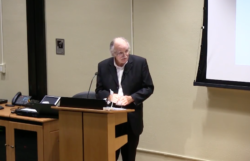Finding Private Ryan: Pushing Back the Republican Tide
Unless the Republican convention in Tampa is swept away by hurricane force winds – itself a fascinating prospect for a party, so many of whose activists claim to be in regular and direct contact with the Almighty – the media will make next week an entirely R week. Monday through Thursday, it will be a Republican week, a Romney week, a Ryan week, a right-wing week, a week dominated by Republican talking points and talking heads.
It will, that is, unless those of us who are not Republicans get out into the public conversation too. The question is how?
Probably not by getting down and dirty, tempting as that is.
Okay, it is probably worth wondering out loud whether the ticket is Romney-Ryan or Ryan-Romney. It is certainly worth mentioning that, for a man who opposed the Obama stimulus, Ryan was remarkably quick to pitch in for that money for his constituents.[1] It is also worth making what political capital we can from the enormous gap between Romney the liberal Republican governor of Massachusetts and Romney the Tea-Party captured candidate for president. But we need to remember that playing down and dirty misses the opportunity provided by the Ryan pick to have a real debate between now and November on the genuine choices that America faces.[2] There are quiet, informed, principled points to be made against the Romney-Ryan Republican platform and record. Using them might more effectively pull over the genuinely undecided, and in a democracy that is how undecided voters ought to be pulled over. So why not try?
How about these 10 things to tell an Independent about the record, claims and promises of the most conservative Republican ticket since Barry Goldwater?
- Neither Romney nor Ryan have yet produced a budget whose numbers make any kind of sense, nor one that is capable of bringing the public finances rapidly back into balance. The Romney economic plan comes with few real numbers, but those include capping all government spending at 20% of GDP (down from 24%), leaving defense spending at 4% and both Medicare and Social Security undisturbed. The non-partisan Center on Budget and Policy Priorities calculated in May that to balance the federal budget within those parameters, a Romney Administration would have to cut “the non-defense programs other than Social Security… [by] 29% in 2016 and 59% in 2022” and that even “without the balanced budget requirement, the cuts would be smaller but still massive, reaching 40% in 2022.”[3] “To make Romney’s numbers add up,” that is, “you have to assume that by the end of his presidency, Romney will have cut every federal program that is not Medicare, Social Security or defense spending by 57 percent.”[4] The parallel Ryan budget – the one passed by the House earlier this year – fares even less well. Summarily dismissed as a “fairy-tale budget plan” by no less than Ronald Reagan’s director of the Office of Management and Budget,[5] the Ryan budget’s projection of federal spending by 2040 has discretionary spending (including on the military) equal to 4.75% of GDP and by 2050 to 3.75%. Yet inside that budget, military spending is due to be maintained or even increased, and it already absorbs more than 4% of GDP. That doesn’t leave much room, or by 2050 any room at all, for a slew of social programs aiding the poor or for environmental controls protecting us all.[6] Both Romney and Ryan remain committed to the full continuation of the Bush-era tax cuts – including those on the super-rich – tax cuts that in Romney’s case would increase the annual federal deficit by almost $500 billion[7] and in Ryan’s would “add $6 trillion to the deficit over the next decade alone.”[8] On these plans, “the government would not run a surplus for three decades, according to the Congressional Budget Office.”[9] So whatever these two characters may be, they are not deficit hawks. They cut discretionary programs with enthusiasm, but they cut taxes on the rich even more enthusiastically.
- Both Romney’s proposals, and those made earlier by Congressmen Ryan, threaten Social Security down the road, Medicare in the middle distance, and Medicaid now. For all their claims that they, and not the President, will strengthen Medicare and guarantee the solvency of these core entitlement programs, nothing could be further from the truth.[10] Sixty-two percent of the proposed cuts in the Ryan budget were to come from low-income programs, particularly Medicaid (to be cut by a staggering one-third over the next decade[11]), food stamps (cut by $133 billion) and Pell Grants (cut for 1 million students).[12] Both men have plans to abolish the Affordable Care Act and to reset Medicaid as a pre-determined block-grant that will not keep up with rising health costs – effectively denying more than 14 million to 19 million of the poorest amongst us the access to adequate health care that the Affordable Care Act guaranteed.[13] Both men plan to turn Medicare into a voucher system for those under 55,[14] effectively pushing the costs of medicine and hospitalization back onto the shoulders of the middle class as they retire (adding $6,200 a year to that burden annually by 2022, according to the Congressional Budget Office[15]). And Paul Ryan at least has in the past canvassed for the very privatization of Social Security that George W. Bush advocated, and which the American people roundly rejected in the last term of his presidency.
- By putting Ryan on the ticket, Romney has aligned himself with the most misogynistic and homophobic program adopted by Republican presidential candidates in modern times. Even before Todd Atkin made his horrendous remarks about “legitimate” rape and the voluntary avoidance of pregnancy, the hidden victims of so much Republican policy were and remain women. Cuts to Medicaid and Medicare are not gender-neutral in a world in which “the majority of Medicare beneficiaries are women, and twice as many women over 65 live in poverty as compared to men.”[16] Cuts to the food stamp program, and to key welfare programs such as TANF[17] and to SSI,[18] are equally burdensome to low-income women, since “nearly nine in ten adult beneficiaries of TANF were women in 2009.”[19] Women stand to gain most too from key elements of the Affordable Care Act that Romney and Ryan would immediately work to repeal: not least from the ban on insurance companies treating the possibility of their pregnancy as a pre-existing condition, and the Act’s support for women’s preventive care. But such cuts are only to be expected from a party that, once in a majority in the House of Representatives, prioritized the passing of new anti-abortion legislation, and is now running as its Vice-Presidential candidate an ultra-socially conservative Catholic with a long track record (a record of which he is proud) of co-sponsorship of 38 anti-abortion measures, and steady support of legislation denying full civil rights to Americans whose sexual orientation happens to differ from his own. For all the candidates’ distancing of themselves from Atkin’s defiant reassertion of misogynistic conservatism, his outburst has simply drawn attention to where the party and its presidential candidates actually stand on women’s rights and on gay marriage. There are shades here of Rick Santorum – with the Republican Party now determined to roll back a slew of civil rights hard-won in struggles that have gone on now for half a century and more – poised, that is, to adopt on Monday a platform more aggressive in its opposition “to women’s reproductive rights and gay rights than any in memory.”[20] Maureen Dowd recently labeled such Republican attitudes “a Taliban creed – evermore antediluvian, anti-immigrant, [and] anti-gay”[21] – and she has a point. Time was when Republicans were keen to push their conservative social agenda, but not anymore. Now they downplay positions that are increasingly out of step with mainstream American opinion – and we need to challenge that downplay every chance we can.
- Shrinking government spending in an economy on the edge of a recession can only trigger that recession, and hurt the most vulnerable members of the society as it does so. This week’s CBO update on the budget and economic outlook for the next decade makes both those things clear. If the Bush tax cuts expire on time and the mandatory spending cuts kick in in January – cuts reluctantly agreed to by the President as the price of last year’s debt-ceiling deal – the CBO expects the economy to stall. It projects “economic conditions in 2013 that will probably be considered a recession, with real GDP declining by 0.5% between the fourth quarter of 2012 and the fourth quarter of 2013, and the unemployment rate rising to about 9% in the second half of…2013.” Not cutting public programs and retaining the Bush tax cuts, by contrast, would leave the economy “stronger in 2013: real GDP would grow by 1.7%…and the unemployment rate would be about 8% by the end of 2013.”[22] Even that is hardly wonderful news, but it is certainly better than a recession deepened by cuts to programs primarily targeted towards low or moderate income groups. The Economic Policy Institute reckon that, were the Ryan budget to be implemented, “the shock to Aggregate Demand from near-term spending cuts would result in roughly 1.3 million jobs lost in 2013 and 2.8 million jobs lost in 2014, or 4.1 million jobs through 2014.”[23] And of course that loss of jobs would happen, because what this economy is short of right now is lack of consumer demand; and you do not boost consumer demand by firing teachers, laying off police officers, and closing down welfare programs.
- The Romney-Ryan plan for economic growth and renewed prosperity is a reworking of the very Reaganite economics that got us into this mess in the first place – and this time is coming at us with an even thinner welfare net than that on offer before. As we have argued on this web-site many times,[24] the United States has now enjoyed two post-war periods of sustained economic growth, both of which ultimately stalled. The first, from 1948-73, was based on a strong manufacturing base, well-unionized workers within the main manufacturing industries, and an associated close relationship between productivity and wage rises. In those years, rising wages and limited income inequality kept aggregate demand high and business confidence buoyant. In the second, put in place in the Reagan years and ended so abruptly by the financial crisis of 2008, the link between productivity and earnings was broken, trade unions were weakened, business deregulation was relentlessly pursued, and income (and wealth) inequality was allowed to soar. Internal demand from middle-class consumers in that second period did not rest on rising wages. It rested on the development of credit-based demand (people borrowed next year’s earnings ahead of time, and paid high interest for the privilege). It rested on more and more members of the family going out to work; and it rested (at its end) on a housing price bubble that briefly turned dwellings into ATM machines for those fortunate enough to own their own home. That ended in 2008 in an orgy of recklessness and misbehavior by inadequately regulated financial institutions – and yet the Romney-Ryan ticket proposes now to return us to that deregulated nightmare. With unemployment so high, wages held low by outsourcing and foreign competition, and a foreclosure crisis still in full flow, all Romney and Ryan offer is more of the same, with the associated federal debt burden reduced only by cutting welfare programs. It is a recipe for a lost decade, possibly for two – decades of economic stagnation and a further erosion of social capital and social cohesion – and it needs to be rejected as such.
- Trickle-down economics is better at distributing wealth from the poor to the rich than it is at creating jobs and rising living standards for middle-class families. If you doubt that, remember the Bush years.[25] It is not as though most of us are being offered a top-down economic miracle for the first time. Most of us have lived through that offer before. Last time the Republicans had the White House, we had trickle-down economics in abundance. Give tax breaks to the ultra-rich, we were told then, and there will be job creation and rising living standards for all. The argument was always guilty of a double standard. Apparently giving tax breaks to the rich made rich people more entrepreneurial, whilst giving modest welfare checks to the poor merely made them welfare dependent and lazy. It was always nonsense. Rates of job creation in the years before the Bush tax cuts ran at levels not seen after the cuts were made: indeed the volume of new employment created in the business cycle over which George W. Bush presided was the lowest in any business cycle in the post-war period; and it was that cycle (and the financial crisis in which it culminated) which then left in its wake unprecedented levels of wealth and income inequality. The data on wealth and income inequality is readily available and unambiguous. The median middle-class family is now no better off than they were in the early 1990s.[26] The distribution of income in this society has returned to levels last seen in the 1970s;[27] and the disparity in wealth (and income) between key ethnic groups is now of a scale not seen since research data first began to be systematically compiled in the early 1980s. [28]
- The Republican faith in the superiority of unregulated markets is just that – faith. Believing it with such intensity flies in the face of both twentieth century American experience and much modern economic theory. In societies as unequal as America’s currently is, markets (responding to consumer demand) must favor those whose demand power carries the greater punch – the American rich. One of the most perceptive commentaries on the Todd Akin debacle treated him as both a participant and a victim of the right-wing media bubble: arguing compellingly that within that bubble certain truths are taken for granted, exchanged regularly as unblemished facts, only to be occasionally rolled out into the wider society, there to be rightly ridiculed.[29] No “truth” is more self-evident in those conservative circles than that governments work best that govern least, that the solution to all economic problems is to roll the government back and let private enterprise flourish. No social outcome is better than one generated by the free play of market forces. Yet in reality markets respond to the power of the consumers within them, and if unregulated produce over time both winners and losers, and consequently economic and social inequality. The capacity of the losers to subsequently win in the market is then corroded by their lack of resources, a deprivation they rapidly pass on to their disadvantaged children.[30] America is currently scarred by deep inequalities of class, race and gender. The least effective way back to a balanced and generally prosperous society is to let market forces compound – without regulation and management – the deep inequalities which they have already created. What is good for the Koch brothers is not good for America, and we need to say so.
- It is not the case that Republicans oppose all forms of big government. They oppose welfare spending but are entirely willing to spend public money in vast quantities on causes for which they and their rich donors care (defense, oil and agriculture to name but three). They are also quite willing to be legislatively present in everybody’s bedroom – saying what can and cannot happen there. The “shrink the government” position of Grover Norquist and his followers suffers from a particular kind of political blindness. It is rarely a shrinking that is meant to apply across the entirety of the federal budget. Of course, there are coherent libertarian positions within the Republican coalition – Ron Paul’s is one – positions that argue for retrenchment of the military budget and role as well as retrenchment of the welfare budget and role. But that libertarian position stands in stark contrast to – and within the current Republican coalition, in serious conflict with –neo-conservative foreign policy hawks on the one side, and Christian social conservatives on the other. The resulting compromise now on offer seems predetermined to strike a balance between the competing factions at a point that is exactly the reverse of what we actually require. The role of government will be kept large on the American imperial project and in the reinforcement of profits for certain large American corporations – particularly those producing armaments, oil, drugs and foodstuffs. The regulatory role of government will be focused on yet further eroding vestigial labor laws protecting working conditions and rewards, and eased back on companies that make money from money rather than money from production; and the welfare role of government will be shredded in favor of welfare provision that is privately provided. All that a Republican-led government will do, in relation to people’s private lives, is impose a “one-model fits all” specification of what a family should be, while systematically removing publicly-funded programs that facilitate the flourishing of family life however organized.
- We are surrounded by successful economies in which governments play a crucial developmental role, and we need such a government here too: one active in developing infrastructure, social capital, and long-term research and development. Getting good-paying jobs back in volume for the middle class requires public investment, not private-sector outsourcing. Which is why the case has to be made again and again that economies with greater degrees of social equality, and a greater role for public bodies in the provision of basic social and economic capital, will be the economies that flourish in the twenty-first century. Economic success will depend increasingly on sophisticated technology, and on high-skilled labor forces able to exploit that technology. Companies will flourish that situate themselves in the midst of world-class transport and communication systems; and innovation and productivity will come from societies that mobilize the full capacities of the entirety of their citizenry, rather than from those relying excessively on the entrepreneurship of the few. The American model used to be of that kind: characterized by world-class mass education lacking in most societies elsewhere; nationally-anchored private capital focused predominantly on servicing and renewing domestic markets; and public provision and policy preoccupied with the maintenance and improvement of basic services and rights. Much of that model was lost in the “winner-take-all” world of the Reagan and post-Reagan years (and with it, America’s economic leadership) and we need to get both back. The Republican Party has lost the plot. They idolize Ronald Reagan and disregard/denigrate FDR. They have the wrong heroes and the wrong policies, and we need to tell the American people so.
- In the end, values count. Who pays the price of economic reconstruction and the mending of America’s broken social system? That is the question. Are you in favor of cutting food stamps or tax breaks on luxury airplanes? There is a basic choice to be made. Do you favor all Americans or only the already favored ones? Budgets, as Jim Wallis has recently written, are moral statements, and those proposed by both Mitt Romney and Paul Ryan are profoundly immoral ones.[31] Where is the morality in a politics that would “raise taxes on families earning between 30 and 40 thousand dollars by almost $500 a year, and slash programs like Medicare, food stamps and children’s health” while reducing “taxes on millionaires by an average of over $500,000 a year.”[32] There is none. The Republican Party base prides itself on its Christian commitments. So where, in their politics, stands the Sermon on the Mount? There is too much St. Paul, and too little Jesus Christ, in the political programs and underlying values of the modern Republican Party.[33] Where have liberal Republicans gone? We need to ask. We need to find them. We need that voice back into the mainstream of the American political debate, to soften and if possible drown out the stridency of the Tea Party.[34] The current Republican Party has gone off on some right-wing rampage, and for the good of both our democratic discourse and our economic future, we need to bring it back.
The Republicans have spent the last four years putting their partisan interests before our general national needs. From the moment Barack Obama took the presidency, Mitch McConnell has been as clear on this as any recent Republican leader has been – that the top and guiding priority of the Republican Party under his leadership in the Senate was and is to make Barack Obama a one-term President. The gridlock in Washington which so frustrates us all, and which has blunted the impact of so many of the President’s policy proposals, is overwhelmingly the responsibility of Congressional Republican legislators – filibustering to a degree not seen before, refusing to play bipartisan politics, moving politically and ideologically rightwards at an alarming speed under Tea Party influence, surrendering the drift of their policy-making to well-financed conservative special interests, and driving their once dominant liberal wing into silence or exile. By blocking every Obama initiative (and even appointments) the Republicans win twice over. They make Obama the President look ineffective, and they make Washington look inefficient: so reinforcing electoral support for their twin-targeted campaign to rid the White House of Obama and America of Big Government.
If Barack Obama’s first term has had one structural weakness, it lies here – in his determined pursuit of agreement with Republicans determined never to agree. In a second term, that weakness is likely to be less in evidence – hence, one assumes, the ferocious determination of the Koch brothers and others to prevent a second Obama term. Independents need to be reminded of who is blocking sane policies for economic reconstruction and social justice in contemporary America. It certainly isn’t the Democratic Party, and next week we need very loudly to say so.
[1] See Juan Cole, Paul Ryan’s Top 10 Falsehoods and Outrages…from Just His First week on the Campaign Trail, posted on AlterNet August 22 2012: available at http://www.alternet.org/election-2012/paul-ryans-top-10-falsehoods-and-outrages-just-his-first-week-campaign-trail
[2] A debate welcomed by commentators on both the left and right. See, for example, Robert J. Samuelson, “Paul Ryan could inspire meaningful debate, “The Washington Post, August 12 2012: available at http://www.washingtonpost.com/opinions/robert-j-samuelson-paul-ryan-could-inspire-a-meaningful-debate/2012/08/12/35b7aab8-e30c-11e1-98e7-89d659f9c106_story.html
and Joe Nocera, “Let the Real Debate Begin,” The New York Times August 13, 2012: available at http://www.nytimes.com/2012/08/14/opinion/nocera-let-the-real-debate-begin.html
[3] Richard Kogan and Paul N. Van de Water, Romney Budget Proposals Would require Massive Cuts in Medicare, Medicaid, and Other Programs, Center for Budget and Policy Priorities, May 21, 2012: available at http://www.cbpp.org/cms/?fa=view&id=3658
[4] Ezra Klein, “The real Romney-Ryan budget cuts aren’t to Medicare. They’re to programs for the poor,” The Washington Post, August 22 2012: available at http://www.washingtonpost.com/blogs/ezra-klein/wp/2012/08/22/the-real-romney-ryan-budgets-cuts-arent-to-medicare-theyre-to-programs-for-the-poor/
[5] David A Stockan, “Paul Ryan’s Fairy Tale Budget Plan,” The New York Times, August 13, 2012, available at http://www.nytimes.com/2012/08/14/opinion/paul-ryans-fairy-tale-budget-plan.html
[6] See Dean Baker, Does Paul Ryan Know What’s In His Budget? Posted on Nation of Change, August 20, 2012: available at http://www.counterpunch.org/2012/08/21/does-paul-ryan-know-whats-in-his-budget/
[7] Paul Krugman, “Policy and the Personal,” The New York Times July 15, 2012: available at http://www.nytimes.com/2012/07/16/opinion/krugman-policy-and-the-personal.html
[8] Matt Miller, “Understanding the Ryan Plan,” The Washington Post, August 12 2012: available at http://www.washingtonpost.com/opinions/matt-miller-the-talented-mr-ryan/2012/08/12/1afaaaa2-e4ad-11e1-936a-b801f1abab19_story.html
[9] In Jackie Calmes, ‘Elevating Ryan, and His Budget Details,” The New York Times August 11, 2012: available at http://www.nytimes.com/2012/08/12/us/politics/ryan-and-his-budget-are-a-gamble-for-romney.html?pagewanted=all
[10] For the CBPP data showing Medicare strengthened by the Affordable Care Act, see Shoring Up Medicare, Center on Budget and Policy Priorities, August 23, 2012: available at http://www.cbpp.org/
[11] Suzy Khimm, “Paul Ryan’s biggest budget cuts are to Medicaid, not Medicare,” The Washington Post, August 13 2012: available at http://www.washingtonpost.com/blogs/ezra-klein/wp/2012/08/13/paul-ryans-biggest-budget-cuts-are-to-medicaid-not-medicare/
[12] Igor Volsky and Pat Garofalo, 4 Ways Paul Ryan’s Budget Would Devastate the Poor, posted at NationofChange, August 19, 2012: available at http://thinkprogress.org/politics/2012/08/17/705401/how-paul-ryans-budget-would-devastate-social-programs-for-todays-lower-income-americans/
[13] Figures from the Kaiser Family Foundation, in E. J. Dionne, “Paul Ryan and the triumph of theory,” The Washington Post, August 12 2012: available at http://www.washingtonpost.com/opinions/ej-dionne-paul-ryan-and-the-triumph-of-theory/2012/08/12/2fa48a94-e4a4-11e1-8f62-58260e3940a0_story.html
[14] Romney’ divergence from Ryan on Medicare funding (his unwillingness to cut the $716 billion from the planned growth of Medicare expenditure on which both Ryan and Obama agree) has the perverse consequence of bringing the insolvency date of the program forward in time to 2016! Obama and Ryan disagree, of course, on how to make those savings and what to do with them. In the Ryan budget, they finance tax cuts. In the Obama budget, they finance access to health care by the poor.
[15] In Jackie Calmes, ‘Elevating Ryan, and His Budget Details,” The New York Times August 11, 2012: available at http://www.nytimes.com/2012/08/12/us/politics/ryan-and-his-budget-are-a-gamble-for-romney.html?pagewanted=all
[16] Bryce Covert, Paul Ryan’s Budget Deals a Body Blow to Women’s Bottom Line, posted on The Nation blog, August 13, 2012: available at http://www.thenation.com/blog/169368/paul-ryans-budget-deals-body-blow-womens-bottom-line#
[17] Temporary Assistance for Needy Families, the program that replaced Aid to Families with Dependent Children in 1996
[18] Supplemental Security Income
[19] Bryce Covert, Paul Ryan’s Budget Deals a Body Blow to Women’s Bottom Line, posted on The Nation blog, August 13, 2012: available at http://www.thenation.com/blog/169368/paul-ryans-budget-deals-body-blow-womens-bottom-line#
[20] Editorial, “What the G.O.P. Platform Represents,” The New York Times August 21, 2012: available at http://www.nytimes.com/2012/08/22/opinion/what-the-gop-platform-represents.html
[21] Maureen Dowd, “Just Think No,” The New York Times August 21, 2012: available at http://www.post-gazette.com/stories/opinion/perspectives/maureen-dowd-just-think-no-650153/
[22] CBO, An Update to the Budget and Economic Outlook: Fiscal Years 2012 to 2022, Congressional Budget Office, Washington DC, 2012: available at http://cbo.gov/publication/43539
[23] Ari Berman, Romney-Ryan Economic Plans Would Increase Unemployment, Deepen Recession, posted on The Nation blog, August 19, 2012: available at http://www.thenation.com/blog/169373/romney-ryan-economic-plans-would-increase-unemployment-deepen-recession
[24] See https://www.davidcoates.net/2010/11/14/fiddling-while-rome-burns/ and https://www.davidcoates.net/2010/09/23/contemporary-poverty-and-the-tasks-of-the-left/
[25] See David Coates, Answering Back: Liberal Responses to Conservative Arguments, New York, Continuum Books, 2010, pp. 34-56
[26] Linda Levine, An Analysis of the Distribution of Wealth Across Households, 1989-2010, Washington DC, Congressional Research Service, July 17,2012: available at www.fas.org/sgp/crs/misc/RL33433.pdf
[27] See CBO, Trends in the Distribution of Household Income Between 1979 and 2007, Washington DC, Congressional Budget Office, October 2011: available at http://www.cbo.gov/publication/42729
[28] Paul Taylor et al, Twenty-to-One: Wealth Gaps Rise to Record Highs Between Whites, Blacks and Hispanics, Washington DC, Pew RDesearch Center, July26, 2011: available at http://www.pewsocialtrends.org/2011/07/26/wealth-gaps-rise-to-record-highs-between-whites-blacks-hispanics/
[29] Josh Barro, Todd Akin and the Right’s False Fact Machine, Bloomberg News, August 21, 2012: available at http://www.bloomberg.com/news/2012-08-21/todd-akin-and-the-right-s-false-fact-machine.html
[30] See David Coates, Making the Progressive Case: Towards a Stronger U.S. Economy, New York, Continuum Books, 20111, pp. 46-47
[31] Jim Wallis, Republican Budget is an Immoral Statement, posted on The Huffington Post, August 2, 2012: available at http://sojo.net/press/jim-wallis-statement-republican-budget
[32] Robert Reich, 5 Reasons Why the Ryan-Romney Economic Plan would Be a Disaster for America, posted on The Huffington Post, August 20, 2012: available at http://www.huffingtonpost.com/robert-reich/romney-ryan-budget_b_1812560.html?utm_hp_ref=elections-2012
[33] See David Coates, Answering Back: Liberal Responses to Conservative Arguments, New York, Continuum Books, 2010, pp. 172-200
[34] Jim Rutenberg, “Jeb Bush Questions G.O.P.’s Shift to the Right,” The New York Times June 11, 2012: available at http://www.nytimes.com/2012/06/12/us/politics/jeb-bush-takes-aim-at-fellow-republicans.html
Tags: 2012 election, big government, budgets, federal spending, homophobia, inequality, Medicaid, Medicare, misogyny, Mitt Romney, Obama, Paul Ryan, Recession, Republican Party, Social Security, trickle down economics, unregulated markets, values
David Coates holds the Worrell Chair in Anglo-American Studies at Wake Forest University. He is the author of Answering Back: Liberal Responses to Conservative Arguments, New York: Continuum Books, 2010.
He writes here in a personal capacity.






US 2012 – Finding Private Ryan: Pushing Back the Republican Tide — Social Europe Journal says:
[…] were to come from low-income programs, particularly Medicaid (to be cut by a staggering one-third over the nextdecade ), food stamps (cut by $133 billion) and Pell Grants (cut for 1 million students). Both men […]